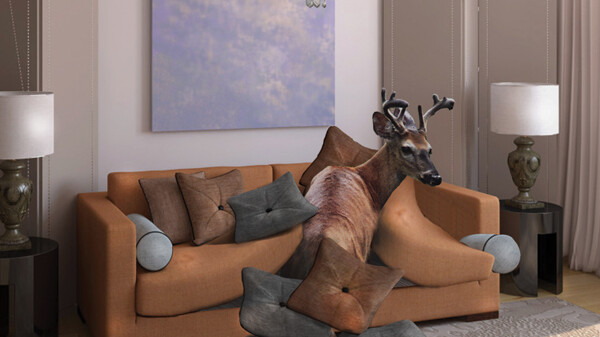Bucking the Trend
what we lose when we see more deer
Mike Paulus, illustrated by Joe Maurer |

Deer can be pretty annoying to people in a city. Certain town-dwelling folk across the great state of Wisconsin have learned to despise the majestic whitetail, seeing them less as a noble animal and more as a giant pesky rat with really long legs, eating all of the pretty bushes in their front yard. A far cry from the timid, fleet-footed deer of yore – seen as brief flashes of fur betwixt mighty oak trees – this new breed of deer has absolutely no problem sauntering right onto your property as if it were their own private buffet.
Invasive deer herds have become such a nuisance in some Midwestern towns that whitetail hit men have been hired to control the population. It’s not a new phenomenon. The joke, of course, is in which mammal is truly “invasive.” Animals were here first, after all. And on top of that, man’s control over the land has directly caused many of those annoying explosions in deer population. Housing divisions reshuffle the wildlife, natural predators are eliminated, lil’ baby deer are born and survive, and so on.
It’s the proliferation of living deer not hanging from a tree that’s becoming less and less weird. I understand why it’s happening. What I’m curious about is what it will lead to. How common will deer in the city become? Will they be like rabbits where we just build chicken wire fences to keep them out of our vegetable gardens?
Unfortunate tales of deer busting into residential homes and area businesses usually make the five o’clock news. So it’s still a novelty when the space animals invade is indoors. For now.
Eau Claire isn’t one of those towns overrun with deer, placing ads on Craigslist for affordable deer assassins. But we seem to see more and more deer every year, right in the middle of our neighborhoods – and not the ones on the edge of town.
A few weeks ago, my family was driving down Skeels Avenue when a six-point buck trotted right up to an intersection we were driving through and waited for us to pass before continuing across the street like it was no big deal. I’ve seen plenty of does and fawns in town, but this buck was new to me. Decades of driving around the countryside of northwestern Wisconsin with my dad have conditioned me to react a certain way when you see a buck. You slow down. You see where it came from and where it’s heading. You think about where it’s eating and sleeping and why it’s on the move. You think about hunting season.
As you may or may not recall, depending upon your ability to remember trivial facts about people you’ve never met, I’m a deer hunter. I can’t say it’s a way of life for me, but it’s an annual tradition I take seriously (and have for over 20 years). Let’s just say the sight of a dead deer in the back of a pickup truck (or hanging in a tree) is not weird or gross to me. I’m often surprised at how novel such a thing is to many of the people I know, people who grew up in Eau Claire or smaller towns. Hunting is a really, really big deal for Wisconsin. How can you escape it?
It’s the proliferation of living deer not hanging from a tree that’s becoming less and less weird. I understand why it’s happening. What I’m curious about is what it will lead to. How common will deer in the city become? Will they be like rabbits where we just build chicken wire fences to keep them out of our vegetable gardens? Will people just stop caring about seeing deer in their yard?
I really hope not. I won’t pretend to know much about the ebb and flow of animal populations in and around urban areas, but it looks like we’ll see more and more deer in the coming years – literally crossing our paths. When will they stop being special? When will they become like giant squirrels? When will they simply annoy us? Perhaps many of you are already there.
I think deer are amazing animals. Like most denizens of the natural world, they can blow your mind, but only if you pull away from your comfort zone and really see them. So the next time you see a deer in someone’s yard, think about the path it walked to get there. Think about why it came. And think about where it’s going.


















